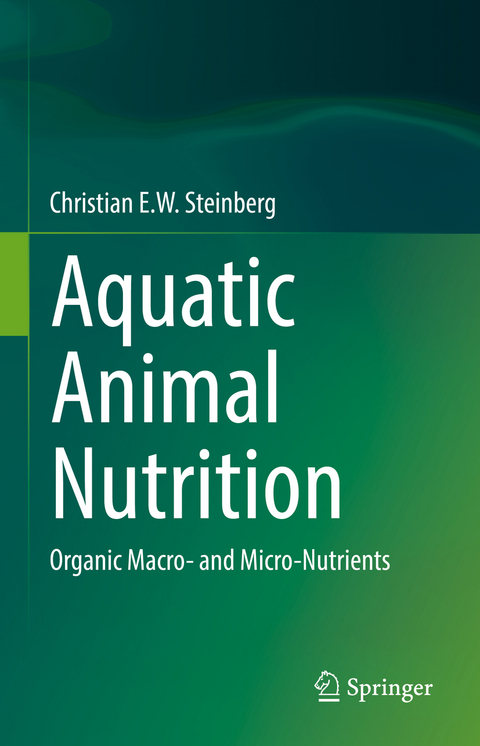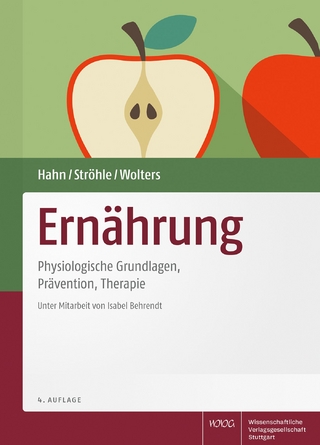
Aquatic Animal Nutrition
Springer International Publishing (Verlag)
978-3-030-87226-7 (ISBN)
As sequel to Aquatic Animal Nutrition - A Mechanistic Perspective from Individuals to Generations, the present treatise on organic macro- and micronutrients continues the unique cross fertilization of aquatic ecology/ecophysiology and aquaculture. This treatise considers proteins and their constituents, carbohydrates from mono- to polysaccharides, fatty acids from free acids to fat, and waxes. It becomes obvious that these organic nutrients are more than only simple fuel for the metabolism of animals; rather, their constituents have messenger and controlling function for the actual consuming individual and even for succeeding generations. This aspect will become particularly clear by putting the organisms under consideration back into their ecosystem with their interrelationships and interdependencies. Furthermore, micronutrients, such as vitamins and nucleotides as well as exogenous enzymes, are in the focus of this volume with known and still-to-be-discovered controlling physiological and biomolecular functions.
Aquatic Animal Nutrition - Organic Macro and Micro Nutrients addresses several gaps in nutritional research and practice. One major gap is the lack of common research standards and protocols for nutritional studies so that virtually incomparable approaches have to be compared. This applies also to the studied animals, since most approaches disregard intraspecific variabilities and the existence of epimutations in farmed individuals. Furthermore, recalling the Mechanistic Perspective from Individuals to Generations, dietary benefits and deficiencies have effects on succeeding generations. In most studies, this long-term and sustainable aspect is overruled by pure short-term production aspects.
By comparing nutritional behavior and success of fishes and invertebrates, Aquatic Animal Nutrition points out different metabolic pathways in these animal groups and discusses how, for instance, fishes would benefit when having some successful metabolic pathway of invertebrates. Application of novel genetic techniques will help turn this vision into reality. However, a widely missing link in the current nutritional research is epigenetics regarding transgenerational heritages of acquired morphological and physiological properties. To increase public acceptance, nutritional optimization of farmed animals based on this mechanism, rather than genetical engineering, appears promising.
lt;p>Christian E.W. Steinberg, educated as ecologist, is interested in pure and applied limnology, particularly aquatic organisms and their nutrition as well as the action of natural aquatic xenobiotic substances. Particularly, humic substances and their long-term impact in entire lake systems as well as their short-term and transgenerational effect in fishes and aquatic invertebrates have been and continue to be studied. Consequently, in 2003, he published the highly acclaimed Ecology of Humic Substances in Freshwater with Springer. The continuation of this research interest led to the identification of beneficial effects of natural mild environmental stresses, for instance, by dissolved humic substances, as ecological driving force and the publication of the 2012 Springer book Stress Ecology.
In 1995, he was appointed chairholder of freshwater ecology at Humboldt University in Berlin and, for 10 years, director of the Leibniz Institute of Freshwater Ecology and Inland Fisheries, Berlin, Germany. He has published approximately three hundred papers in peer-reviewed journals and was frequently appointed guest professor at Salzburg University (Austria), Universidade Federal do Rio de Janeiro (Brazil), Huazhong Agricultural University Wuhan (China), and, since 2009 permanently, Kunming University of Science and Technology (China).
Chapter 1. Introduction.- Chapter 2. Protein Requirement.- Chapter 3. Utilization of Proteinaceous Nutrients.- Chapter 4. Peptides or Amino Acids?.- Chapter 5. Amino Acid Functions and Requirements.- Chapter 6. Simple Amino Acids: Gly, Ala, Asp, Gln.- Chapter 7. The Versatile Amino Acid: Tryptophan.- Chapter 8. A Bunch of Amino Acids: Phe, Tyr, Branched-Chain AAs, Ser, Thr.- Chapter 9. Sulfur Amino Acids.- Chapter 10. Basic Amino Acids and Prolines.- Chapter 11. Taurine.- Chapter 12. Nonprotein Amino Acids.- Chapter 13. Glucose.- Chapter 14. Glucose Homeostasis.- Chapter 15. Glucose Intolerance.- Chapter 16. Carbohydrate Transport.- Chapter 17. Protein Sparing by Carbohydrates.- Chapter 18. Carbohydrate Preference and Metabolism.- Chapter 19. Regulatory Potential of Carbohydrates.- Chapter 20. Oligosaccharides.- Chapter 21. Starch.- Chapter 22. Non-Starch-Polysaccharides & Fibers.- Chapter 23. Lipids.- Chapter 24. Lipid Homeostasis.- Chapter 25. Protein Sparing by Lipids.- Chapter 26. Fatty Acids.- Chapter 27. Essential Fatty Acids.- Chapter 28. Biosynthesis of Polyunsaturated Fatty Acids.- Chapter 29. PUFAs in Reproduction and Behavior.- Chapter 30. Trophic Transfer of PUFAs.- Chapter 31. Sterols, Phospholipids, Wax Esters.- Chapter 32. Vitamin A.- Chapter 33. Vitamin B.- Chapter 34. Vitamin C.- Chapter 35. Vitamin D.- Chapter 36. Vitamin E.- Chapter 37. Vitamin K.- Chapter 38. Nucleotides.- Chapter 39. Exogenous Enzymes.- Chapter 40. Intraspecific Variability.
| Erscheinungsdatum | 07.01.2022 |
|---|---|
| Zusatzinfo | XVI, 1084 p. 358 illus., 199 illus. in color. |
| Verlagsort | Cham |
| Sprache | englisch |
| Maße | 155 x 235 mm |
| Gewicht | 1318 g |
| Themenwelt | Medizin / Pharmazie ► Gesundheitsfachberufe ► Diätassistenz / Ernährungsberatung |
| Naturwissenschaften ► Biologie ► Ökologie / Naturschutz | |
| Naturwissenschaften ► Biologie ► Zoologie | |
| Schlagworte | carbohydrates • Fish lipids and oil replacements • Functional Food • Phyto- and mycotoxins • Proteinaceous Nutrients • Stirring effects of macro- and micro-nutrients |
| ISBN-10 | 3-030-87226-2 / 3030872262 |
| ISBN-13 | 978-3-030-87226-7 / 9783030872267 |
| Zustand | Neuware |
| Haben Sie eine Frage zum Produkt? |
aus dem Bereich


